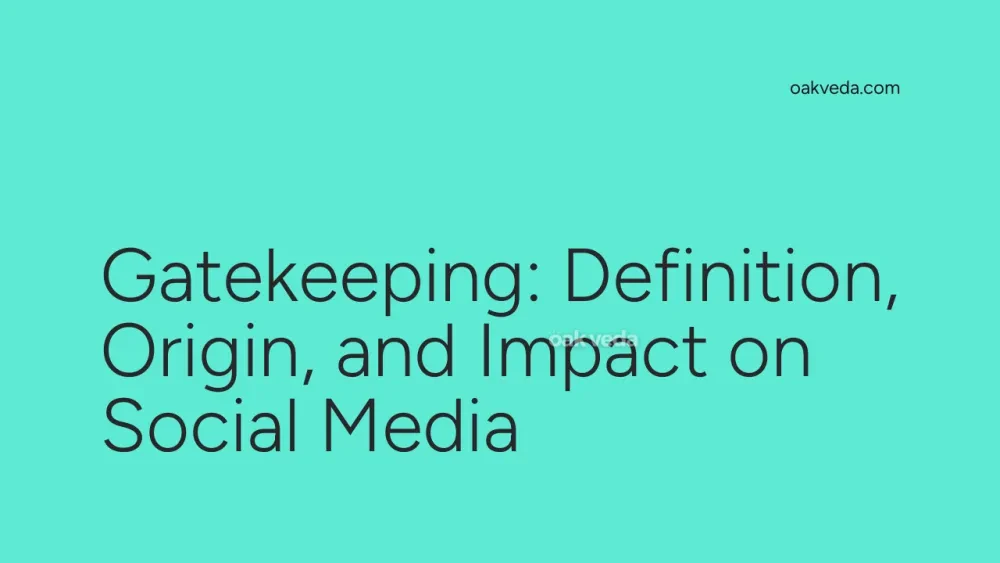
What is Gatekeeping?
Gatekeeping in the context of social media refers to the act of controlling or limiting access to information, resources, or opportunities within online communities. It involves individuals or groups who intentionally withhold knowledge, restrict participation, or define what is acceptable within a particular digital space. This practice can significantly influence the dynamics of online interactions and shape the flow of information across various platforms.
Origin and Development of Gatekeeping
The concept of gatekeeping predates social media, originating in traditional media and communication studies. Kurt Lewin, a social psychologist, first introduced the term in the 1940s to describe how information flows through channels controlled by "gatekeepers." As social media platforms emerged and evolved, the concept of gatekeeping adapted to the digital landscape, taking on new forms and implications in online communities.
How Gatekeeping Works on Social Media
On social media, gatekeeping manifests in various ways:
- Information control: Users may withhold or selectively share information to maintain exclusivity or influence.
- Community management: Moderators or influential users define and enforce rules within online groups.
- Cultural gatekeeping: Individuals or groups determine what is considered authentic or acceptable within specific subcultures.
- Platform algorithms: Social media algorithms can act as gatekeepers by controlling content visibility and reach.
Gatekeeping can be both intentional and unintentional, often reflecting power dynamics and hierarchies within online communities.
Types of Gatekeeping on Social Media
- Content gatekeeping: Controlling what type of content is shared or promoted within a community.
- Access gatekeeping: Limiting who can join or participate in certain online spaces or discussions.
- Knowledge gatekeeping: Withholding information or expertise to maintain a position of authority.
- Cultural gatekeeping: Defining who is considered a "true" member of a subculture or fandom.
- Algorithmic gatekeeping: Platform-driven content curation that influences what users see and engage with.
Popular Examples of Gatekeeping
- Exclusive Discord servers: Private communities that restrict access to select members.
- Influencer product sourcing: Creators refusing to disclose where they purchased items to maintain exclusivity.
- Fandom gatekeeping: Long-time fans questioning the authenticity of newcomers to a franchise or community.
- Professional networking: Limiting access to job opportunities or industry connections within closed groups.
- Trend gatekeeping: Users claiming ownership of trends or styles and criticizing "inauthentic" adoption.
Impact of Gatekeeping on Social Media Culture
Gatekeeping has both positive and negative effects on social media culture:
Positive impacts:
- Maintaining quality standards within communities
- Protecting vulnerable groups from harmful content or individuals
- Preserving cultural authenticity and traditions
Negative impacts:
- Limiting diversity and inclusion within online spaces
- Stifling innovation and fresh perspectives
- Creating elitism and exclusionary behavior
- Hindering the free flow of information and ideas
Controversies and Debates Surrounding Gatekeeping
The practice of gatekeeping on social media has sparked numerous debates:
- Inclusivity vs. exclusivity: Balancing the need for safe spaces with the desire for open, diverse communities.
- Authenticity vs. gatekeeping: Distinguishing between preserving cultural integrity and exclusionary practices.
- Platform responsibility: Determining the role of social media companies in moderating gatekeeping behaviors.
- Freedom of expression: Navigating the line between community standards and censorship.
- Algorithmic bias: Addressing concerns about platform algorithms perpetuating gatekeeping through content curation.
How Brands and Influencers Use Gatekeeping
While gatekeeping is often viewed negatively, some brands and influencers leverage it strategically:
- Exclusive content: Creating members-only spaces or paywalled content to increase perceived value.
- Limited-time offers: Using scarcity tactics to drive engagement and sales.
- Influencer collaborations: Partnering with gatekeepers of niche communities to access targeted audiences.
- Community building: Fostering a sense of belonging through selective access or insider knowledge.
- Brand authenticity: Maintaining brand identity by carefully curating partnerships and content.
Future Trends Related to Gatekeeping
As social media continues to evolve, several trends are emerging:
- Decentralized platforms: The rise of blockchain-based social networks may challenge traditional gatekeeping structures.
- AI-driven moderation: Advanced algorithms could help balance gatekeeping and open access more effectively.
- Increased transparency: Growing demand for clear community guidelines and moderation practices.
- Niche communities: Proliferation of smaller, more focused online spaces with specific gatekeeping practices.
- Digital literacy education: Greater emphasis on teaching users to navigate and critically assess online gatekeeping.
FAQs about Gatekeeping
-
Is all gatekeeping bad? No, some forms of gatekeeping can help maintain quality standards and protect communities. However, excessive or discriminatory gatekeeping can be harmful.
-
How can I recognize gatekeeping on social media? Look for exclusionary language, reluctance to share information, or attempts to define who "belongs" in a community.
-
Can gatekeeping be positive? Yes, when used responsibly, gatekeeping can help maintain safe spaces, preserve cultural integrity, and ensure quality content.
-
How do social media platforms address gatekeeping? Platforms often implement community guidelines, moderation tools, and algorithms to balance open access with community standards.
-
What can users do to combat negative gatekeeping? Promote inclusivity, share knowledge openly, challenge exclusionary practices, and create welcoming spaces for diverse voices.
In conclusion, gatekeeping on social media is a complex phenomenon with far-reaching implications for online communities. While it can serve important functions in maintaining community standards and cultural integrity, it also has the potential to create barriers and reinforce existing power structures. As social media continues to evolve, finding a balance between openness and curation will remain a critical challenge for platforms, brands, and users alike.
You may be interested in:
- NPC (Non-Player Character): Definition, Origin, and Impact
- Side-Eye: Definition, Origin, and Impact on Social Media
- Link-in-Bio: Definition, Origin, and Impact on Social Media
- Verified: Definition, Origin, and Impact on Social Media
- Follow Friday: Definition, Origin, and Impact on Social Media
- Double-Tap: Definition, Origin, and Impact on Social Media

